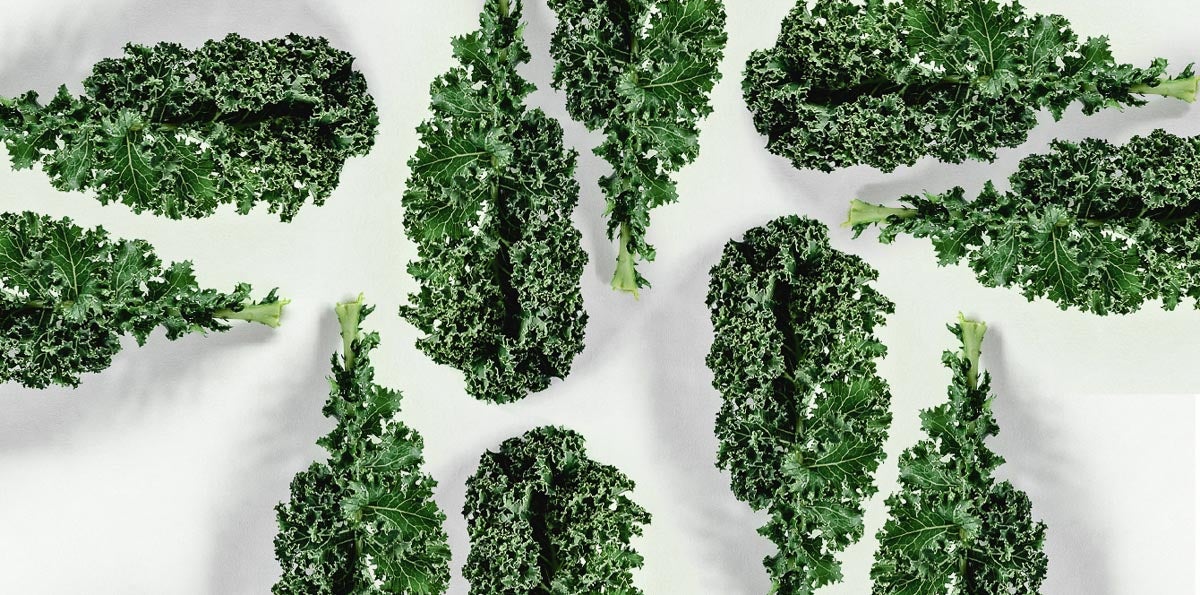The past few months have been terrifying, but also cathartic. The pandemic has shaken most of us from a false sense of security about our individual health, the efficacy of our cities to provide a high quality of life, and forced us to question many of our daily habits — how we live, work, travel and exercise, as well as how we source the food we eat. Our connection to nature. The primary lesson we, once again, must learn is that cities are not divorced from nature. They are a part of the larger biome in which they’re located.
As planners and designers, we are trained to think holistically. While these fields of study promote cities as beneficial, no city is perfect — not even close, and the vulnerabilities and interconnections of the global supply chain has impacted all of us in unforeseen ways. In this post and others, I will delve into the benefits of reconnecting to basic processes that support our daily needs, such as the growing of plants for food, increasing equity in our local communities and local food security. I will look at models from the past that promoted urban gardens and gardeners, and show what worked and what did not. I will discuss the opportunities and challenges of being an urban gardener, what is needed to set up a garden of your own, and what laws and standards stand in the way of making cities better at promoting urban gardens.
Growing up in the rural Midwest, there always was a close connection to the food that we ate. My mother was a gardener, and my father came from a farming and hunting family. That all changed when I went to college. For the next 25 years, I was so focused on work that I never had the time to think about where my food came from. Then I started growing flowers, and my connection started to return. Plants grow on their own schedule, they don’t care if you have deadlines or travel, they need water and sun and good soil to thrive. You accommodate them. The attraction for me was to get out of my head for a few moments a week and focus on what the plants needed to grow. That interest grew into understanding more deeply the connection between how cities and plants flourish.
My interest in becoming more self-reliant grew, and out of that came four objectives:
1) I was interested in getting away from producing so much waste, and instead producing topsoil, food and healthy habits for my family.
2) I wanted to see how much food I could produce — was it too audacious of a notion to produce 40% of my vegetables like the victory gardeners of World War II? Could I grow more than 40%?
3) In an urban setting, what are the particulars of raised beds, pots, water scarcity and a small amount of storage that I needed to learn?
4) How do I pick the right plants? What would grow and what wouldn’t?
What follows is an account of the issues, trials and errors from working my small plots.
Consider the sun
Our family lives in a townhouse in the community of Venice Beach, a suburb of Los Angeles. We do not have a yard per se, but we do have a deck that wraps around the property. It mostly faces northeast, but a portion faces northwest as well. ‘Too bad,’ you might say, ‘you only get morning and late afternoon sun;’ however, I will tell you it’s a good thing.
From March through September, I get full sun from about 7 a.m. to around noon, which is plenty of sun for most vegetables to grow. The sun gets hot in the afternoon, so once it ducks behind our building, the plants have an opportunity to cool down.
Further, just because you don’t have direct sun does not mean you cannot grow vegetables. One of my neighbors has a garden facing due north, and she can grow kale, collards and lettuces with no problem. Just as not enough sun increasingly is an issue with climate change, you also have to be aware of getting too much sun, as well as reflectivity off buildings, which can cook plants. Ways to mitigate this condition are to provide awnings or other shading devices where appropriate.
I have an area that gets afternoon sun, so I alternatively planted my vegetable plots with drought tolerant plants that can provide shade in the afternoon for the lower vegetables like leafy greens, which can burn with too much sun. Succulents retain moisture in their roots and therefore keep the soil somewhat hydrated in between watering cycles. Other plants such as cilantro, fennel and dill are good at repelling aphids and other pests. The point is, when you are planting, think of the symbiosis of certain plants to provide shade, moisture and protection from your edible plants.
Waste not, water more
You probably have heard that access to water is a big problem in South Africa. What you might not know is that the government has teamed up with a group of South African pop stars to craft a series of two-minute 'shower songs' to help people save water. Here in Southern California, we have our own rules and regulations about water usage, but few of us think about how our shower time contributes to water usage.
The average shower in the U.S. is 8 minutes long. The Centers for Disease Control and Prevention offers guidelines for showers, and advises that showering for longer than 15 minutes can contribute to health problems such as skin conditions … duh! I have three daughters with long, flowing hair, so I am conscious that they might need a bit more time in the shower than me. I decided to create a system that captures some of the water we don’t use before it gets hot. It’s not complicated: just a bucket set up under the shower head to catch the cold water that comes out when you turn on the shower. A typical low-flow shower head distributes 2.5 gallons of water per minute. So, in a week I capture more than 15 gallons of water, which I put into our rain barrel for watering our garden.
Vegetables are thirsty and need to be watered at least once a day. We use about twice that amount of water on our garden, but I am glad we are at least getting half of our water from another source than the garden hose. If we want to build a sustainable city, we need to make it easier to divert water from domestic uses that are water intensive.
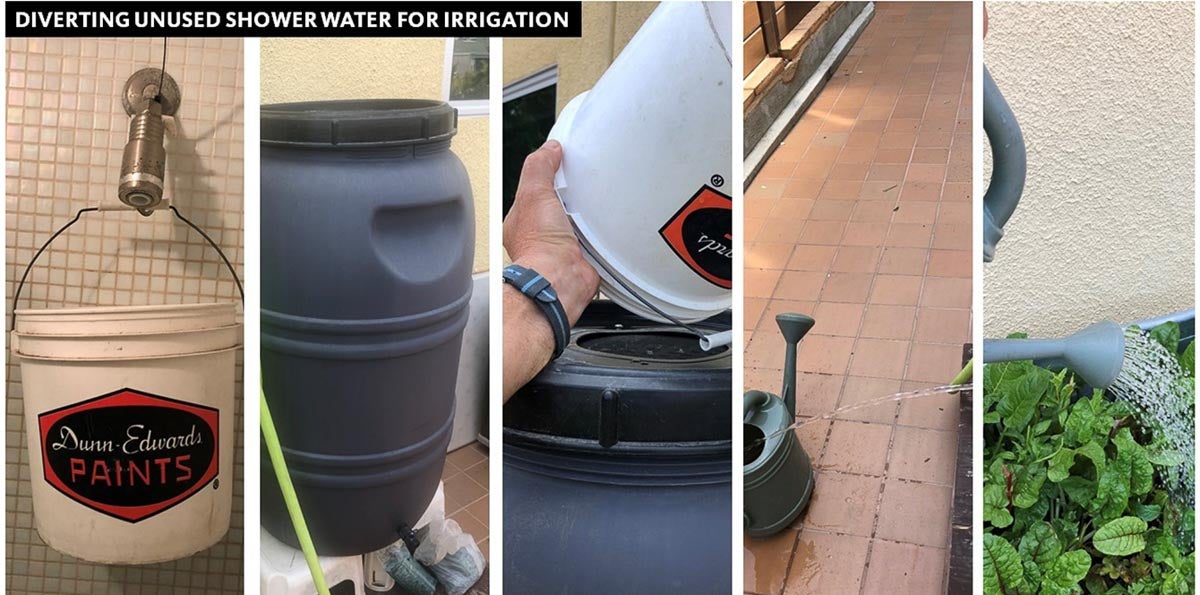
Winds and losses
Being on the coast presents an interesting challenge in terms of the wind. As the city heats up in the afternoon, onshore flow makes the wind blow, often up to speeds of 30 mph or more. What this does is two things. First, leafy vegetables with lots of water in them, like lettuces, dry out quickly, making daily watering a must. Mixing these vegetables with other plants that have heartier leaf structures and can take wind, such as swiss chard, kale, collards and beans, can help mitigate the wind’s effects by keeping moisture in the soil.
There is significant documentation to suggest that urban areas can increase wind speed compared to rural areas. The effects of the phenomenon called wind shear can definitely affect soil quality in urban gardens. How so? Wind desiccates (dries) the soil, making it less capable of holding moisture and nutrients. We are losing our topsoil at a frightening pace. According to a recent Stanford University study, as much as 1% of the Earth’s topsoil is lost each year. So, not only is plant choice important in urban gardens, getting the right amount of topsoil that is full of enough nutrients to support root growth is essential. Of course, anybody can buy topsoil at a garden supply store, but I wanted to commit to composting as a way of closing the loop and move toward a more regenerative model of living by creating at least some of my own topsoil.
Make the most of compost
One of the primary challenges in urban gardening is soil quality. Near the beach where I live, the soil is mostly sand and not able to grow plants. For many gardeners, composting is a passion. Every week, millions of Americans collect grass clippings and combine them with kitchen waste and dig out perfect compost from the bottom of the heap. Packed with worms and rich in nutrients from broken down leaves and grasses, this soil is like ‘black gold’ for plant growth!
What exactly is compost? It is a mixture of “brown” materials and “green” materials. Brown materials, which are fibrous, drier and more woody (such as dry leaves, shredded newspaper, coffee grounds), are largely inert and fibrous. “Green” materials are soft, leafy, moist, high in nitrogen and low in fiber. They include kitchen peelings and food wastes that are mostly green. They lead to high temperatures in the compost as it breaks down.
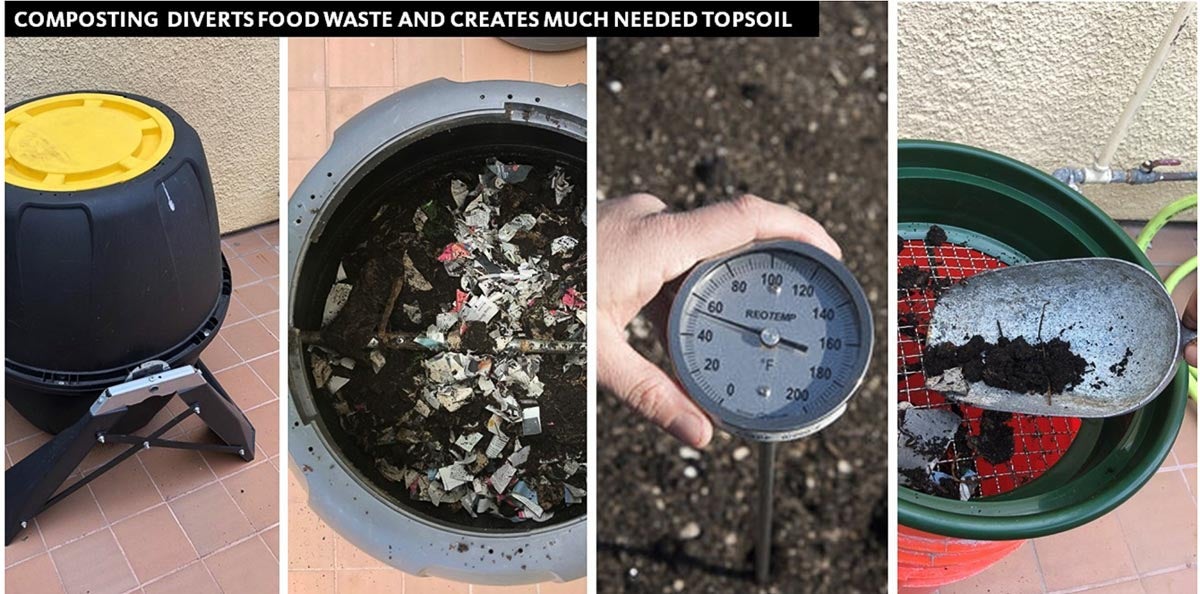
It’s important to get the mixture right because the chemical processes and microbes need a combination of fuel and volume to break down the mix over time. The ratio of brown to green materials should be about 75%:25%.
Compost is made by these ingredients being mixed and decomposing into what becomes topsoil. Urban composting can be a challenge because many urban gardeners don’t have big lawns or piles of leaves. I have made compost for years from a combination of kitchen scraps (mostly vegetable clippings and coffee grounds) compost starter and shredded newspaper.
Tumbling composters can be effective to accelerate the breakdown of compost materials, but to work properly, the material must heat up to between 120 and 170 degrees Fahrenheit. You need a composting thermometer to make sure your compost is getting hot enough to begin to decompose. Ideally, the right mix of materials under the right conditions can break down in 30–60 days, but it might take longer. Urban composters tend to be small, and typically you need about one cubic yard for compost to work effectively. If you cannot dedicate that much space to it, a tumbler composter is a good tool. It allows aeration to occur more quickly, thereby accelerating production.
Once the compost is broken down, you need to let it 'cure' for a couple weeks before you can scoop it out for use. I use a half-inch sifting pan to separate out the big clumps from the finer, crumbly soil, which can be sprinkled around your plants for a great nutritional boost.
Composting closes the loop on food waste that would otherwise end up in a landfill or be ground up in our kitchen disposals. When made correctly, compost is rich in nutrients that promote plant growth and it reduces the need for fertilizers that are detrimental to soil health and water quality. However, it needs to be said that composting takes a lot of patience. I would say I have been able to produce about 25% of the soil needed to support the garden I have. It’s been a worthwhile exercise for my family to better understand how soil works and to gain an appreciation for the fragility of our biome!
Putting stock in raised beds
Having a terrace and no real yard to speak of means that I am relying on planter beds to grow plants. One of the easiest ways to do this is to use stock tanks, which are available at large hardware suppliers. I use 100-gallon stock tanks because they are sturdy, large and high enough to be easily worked on. The galvanized walls of the tanks reduce the chances of squirrels or other rodents climbing the walls in search of food. Holes need to be drilled in the bottom to encourage good drainage. I put about three inches of river stones in the bottom of the tank, then fill to about six inches below the top of the tank with potting soil.
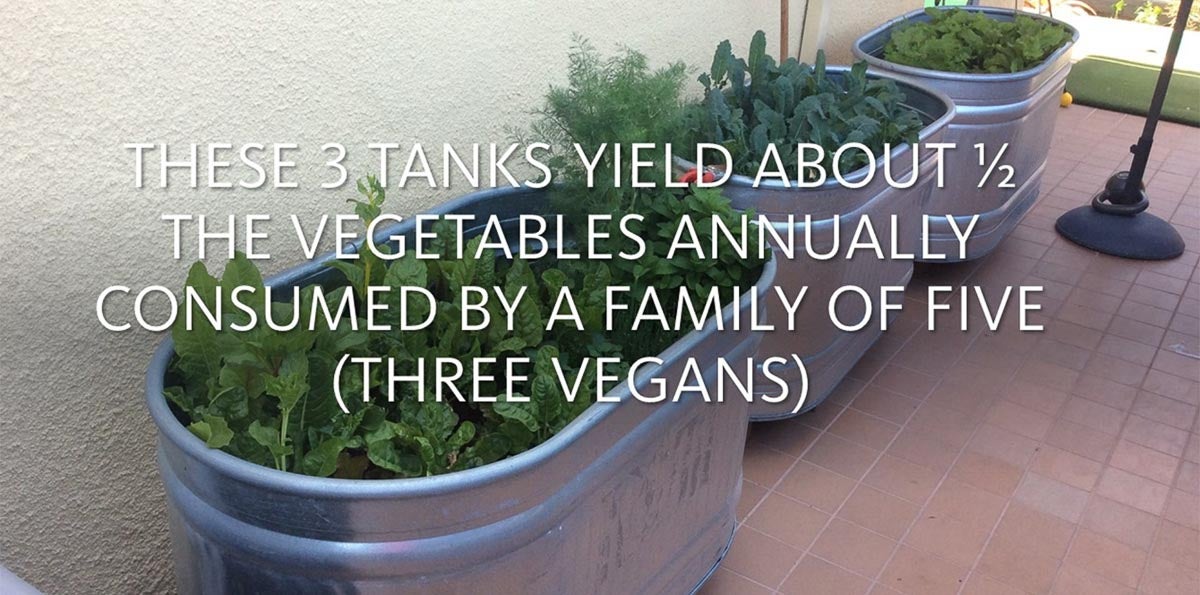
What to plant
In the wintertime, the lower temperatures tend to be better for lettuces and greens with thicker, more hearty leaf structure, such as kale, swiss chard, collards and arugula. Another benefit of these leafy greens is that their growing season is shorter, often bearing as quickly as 30-45 days. I have three planter beds that total about 24 square feet of area. When these plants start bearing, they can provide the salad greens we as a family of five eat. Herbs like dill, chives, mint and other leafy structures grow well year-round.
Later in the year, as it gets warmer, fruit-bearing vegetables such as peppers, tomatoes and the like are possible, but I will caution they take much longer to bear—often 90 days or more—attract insects and animals looking for food, and often, without a greenhouse, can be more trouble than they are worth. Don’t rely on these as staple vegetables, they don't bear fast enough. Other areas of my property are much shadier and less desirable for growing plants.
So, all in all, with three large planter beds and relying on mostly leafy greens, I can grow about 50% of our yearly vegetable intake; and the materials required to set up my operation: stock tanks, seeds, rain barrel, composting bin, thermometer, composting screen, etc., all cost less than $1,000 to set up. By producing $20-$40 in fresh vegetables per week, the set-up has paid for itself in less than a year. Not only does all this effort help the planet, it is a significant cost savings to our family; nothing to discount with three kids on the way to college!
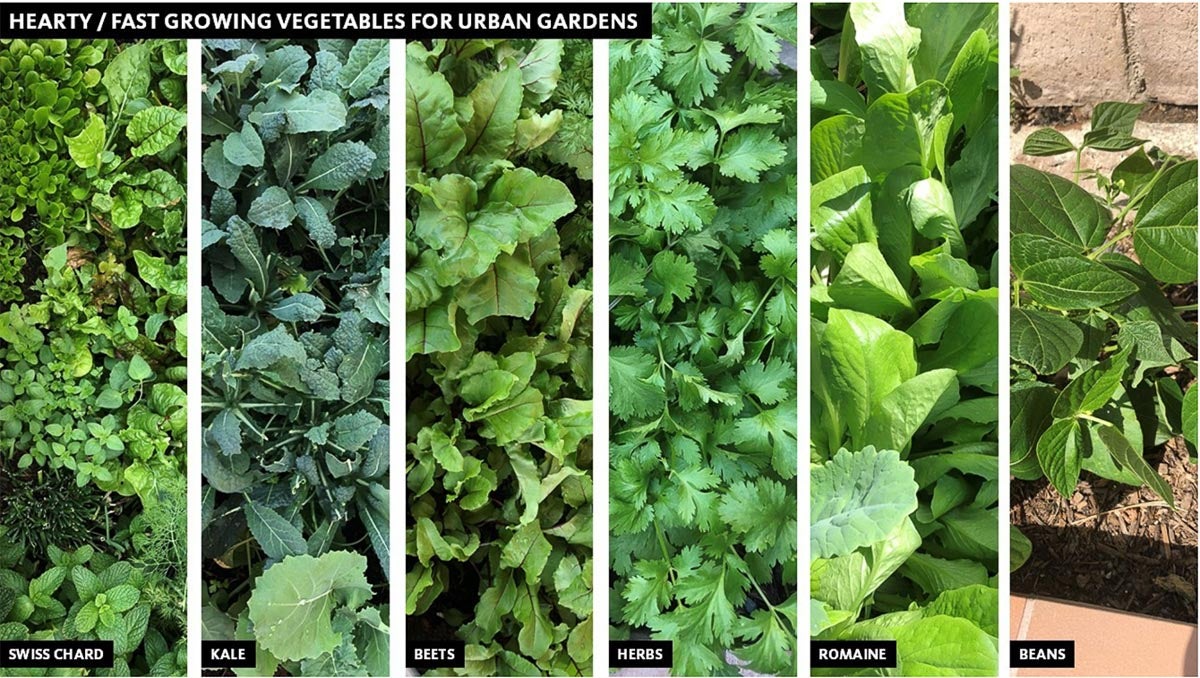
Breaking barriers to city gardening
The impact of the pandemic has brought to our attention the shortcomings of cities in dealing with many issues, and of particular note is food insecurity. As the disparity between rich and poor continues to widen, and the risks of the global supply chain are exposed, one of the best things we can do as leaders is to encourage the development of urban gardens in cities. They combat heat islands, increase fresh air, and provide inexpensive and renewable community food supplies. In addition, proximity to gardens has been found to stimulate healing and improve mental health.
Barriers to success in this regard include the cost of supplies, solar access and shielding plants from wind, ready access to water, and soil quality. The city of the future needs to better accommodate the needs of a community focused on personal health and wellness. As I have discussed in previous blog posts, integrating gardens into cities for health and wellness purposes is not a new idea, but there are some significant barriers to modern planning that discourage urban gardens from proliferating.
In the next installment of this series on the “urban gardener,” I will look at some common-sense ideas that would make cities more green, productive and healthy places for everyone.
Nate Cherry is a planning director for Gensler's Los Angeles-based Planning and Urban Design group. Gensler is a global architecture, design and planning firm.
The views, information or opinions expressed in this post are those of the author and do not necessarily represent those of the Kinder Institute for Urban Research.

